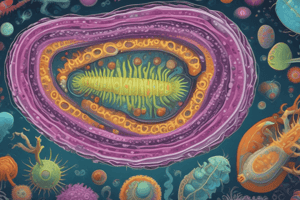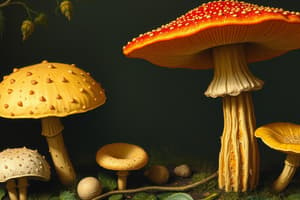Podcast
Questions and Answers
Select all of the following that are impacts of protists on global ecology. (Select all that apply)
Select all of the following that are impacts of protists on global ecology. (Select all that apply)
- Protists have no impact on global ecology.
- Protists cause serious diseases, such as malaria. (correct)
- Protists produce at least half of the oxygen in the Earth's atmosphere. (correct)
- Algae are being used in biofuel production. (correct)
Diverse protists that possess saclike membrane vesicles at the cell periphery are classified in the supergroup called?
Diverse protists that possess saclike membrane vesicles at the cell periphery are classified in the supergroup called?
Alveolata
Examples of defensive adaptations in protists include?
Examples of defensive adaptations in protists include?
- Silica cell walls
- Cellulose cell walls
- Toxins
- All of the above (correct)
An organism that ingests food particles through the plasma membrane and digests them in vesicles within the cytoplasm is a(n)?
An organism that ingests food particles through the plasma membrane and digests them in vesicles within the cytoplasm is a(n)?
Protists that employ the haploid dominant life cycle may produce what pairs of gametes?
Protists that employ the haploid dominant life cycle may produce what pairs of gametes?
The life cycle employed by many multicellular green and brown algae that involves a switch between haploid gametophyte cells and diploid sporophyte cells is called the ______ life cycle.
The life cycle employed by many multicellular green and brown algae that involves a switch between haploid gametophyte cells and diploid sporophyte cells is called the ______ life cycle.
Which of the following statements best characterizes the impact of protists on human health?
Which of the following statements best characterizes the impact of protists on human health?
Which of the following are characteristics of at least some members of the supergroup Alveolata?
Which of the following are characteristics of at least some members of the supergroup Alveolata?
Heterotrophic protists that feed by ingesting particles, or phagocytosis, are known as?
Heterotrophic protists that feed by ingesting particles, or phagocytosis, are known as?
What type of protist is likely to display a haploid dominant life cycle?
What type of protist is likely to display a haploid dominant life cycle?
Multicellular green and brown seaweeds undergo a life cycle known.............of....................
Multicellular green and brown seaweeds undergo a life cycle known.............of....................
Meiosis and the production of cysts, spores, gametes, and zygotes are all adaptations employed by protists for?
Meiosis and the production of cysts, spores, gametes, and zygotes are all adaptations employed by protists for?
Protists are?
Protists are?
Protists can be grouped into three types according to the roles they fulfill within their environments, which are?
Protists can be grouped into three types according to the roles they fulfill within their environments, which are?
Plankton, phytoplankton, and periphyton are informal groupings of protists classified according to?
Plankton, phytoplankton, and periphyton are informal groupings of protists classified according to?
The term protist comes from a Greek word that reflects the observation that these organisms were Earth's?
The term protist comes from a Greek word that reflects the observation that these organisms were Earth's?
Organisms within the Protista can be informally grouped based on?
Organisms within the Protista can be informally grouped based on?
Which of the following are informal groups of protists classified according to habitat?
Which of the following are informal groups of protists classified according to habitat?
Protists have evolved diverse ways for locomotion. For example, swimming can occur by means of appendages called.................and...............
Protists have evolved diverse ways for locomotion. For example, swimming can occur by means of appendages called.................and...............
Newly discovered species and results from molecular genetic methods have resulted in?
Newly discovered species and results from molecular genetic methods have resulted in?
The cellular process by which an organism obtains energy from a food particle by digesting the particle with enzymes inside a cytoplasmic vesicle is known as?
The cellular process by which an organism obtains energy from a food particle by digesting the particle with enzymes inside a cytoplasmic vesicle is known as?
In endosymbiosis, the endosymbiont lives?
In endosymbiosis, the endosymbiont lives?
Which of the following are characteristics of at least some members of the supergroup Rhizaria?
Which of the following are characteristics of at least some members of the supergroup Rhizaria?
Protist classification continues to change because?
Protist classification continues to change because?
The process in which an organism consumes an object by surrounding the object in a vesicle of plasma membrane, which then pinches off within the cytoplasm, and digesting the object by secreting enzymes within the vesicle is known as?
The process in which an organism consumes an object by surrounding the object in a vesicle of plasma membrane, which then pinches off within the cytoplasm, and digesting the object by secreting enzymes within the vesicle is known as?
In an intimate relationship between two organisms, the smaller species that lives within the body of the larger species is known as the?
In an intimate relationship between two organisms, the smaller species that lives within the body of the larger species is known as the?
Swimming cells with a single, posterior flagellum are known as?
Swimming cells with a single, posterior flagellum are known as?
Flashcards are hidden until you start studying
Study Notes
Impacts of Protists
- Protists are responsible for serious diseases, including malaria.
- They contribute significantly to atmospheric oxygen production, generating at least half.
- Algae derived from protists play a vital role in biofuel production.
Classification and Characteristics
- Protists with saclike membrane vesicles and possible cilia or flagella belong to the supergroup Alveolata.
- Defensive adaptations in protists include silica and cellulose cell walls, toxins, and mucilage secretion.
- Heterotrophic protists that ingest particles are classified as phagotrophs or phagotrophic.
Life Cycles
- Protists exhibiting haploid dominant life cycles produce gametes with + and - mating types, and sperm and eggs.
- Many multicellular green and brown algae utilize the "alternation of generations" life cycle.
Human Health and Disease
- Some protists act as parasites, causing significant human diseases.
Ecological Roles
- Protists can be categorized based on their ecological roles, such as being part of plankton, phytoplankton, and periphyton.
- Informal groupings of protists depend on their habitat.
Locomotion and Evolution
- Locomotion in protists can be achieved through flagella and cilia.
- The classification of protists is dynamic, adjusting as new species are discovered and molecular genetic methods enhance understanding of relationships.
Nutrition and Energy Acquisition
- Energy acquisition involves phagocytosis, where organisms digest food particles within vesicles using enzymatic action.
Symbiotic Relationships
- In endosymbiosis, smaller organisms, known as endosymbionts, live within the bodies of larger hosts.
Genetic Relationships and Adaptations
- Adaptations in protists include the production of cysts, spores, and gametes for reproduction.
- Observations reveal that protists are among the first eukaryotes on Earth.
Membership and Specialized Features
- Some members of the supergroup Rhizaria exhibit secondary green plastids and filose pseudopodia.
- Newly discovered species and molecular methods lead to evolving protist classifications.
Studying That Suits You
Use AI to generate personalized quizzes and flashcards to suit your learning preferences.




